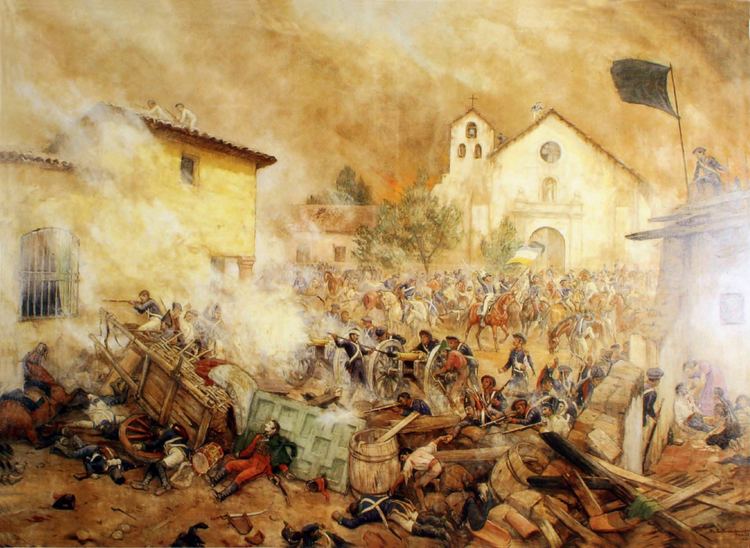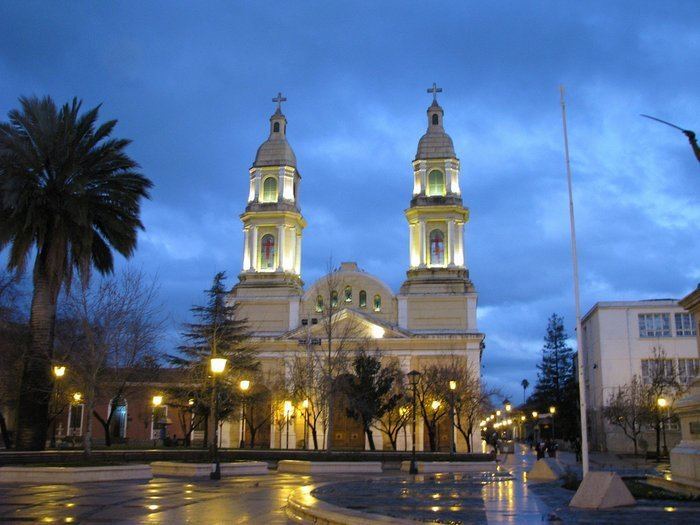Area 260.3 km2 | ||
 | ||
Map of Rancagua
Rancagua ([raŋˈkaɣwa]) is a city and commune in central Chile and part of the Rancagua conurbation. It is the capital of the Cachapoal Province and of the O'Higgins Region, located 87 km (54 mi) south of the national capital of Santiago.
Contents
- Map of Rancagua
- Himno de rancagua chile rancagua city anthem chile
- Foundation period
- Today
- Demographics
- Notable people born in Rancagua
- Administration
- Culture
- Climate
- Sports
- Stadiums and arenas
- Twin townsSister cities
- References

Its first name was Santa Cruz de Triana. In 2012, its population was 232,211. The main economic activities range from mining, tourism, agriculture, timber, food production and services to minor industrial activities. The city also serves as the administrative and legal center of the region.
Next to Machalí and Gultro forms the Rancagua conurbation; and next to Curicó, Talca and Concepción, is one of the most important and populated cities of the south central zone of Chile.
Himno de rancagua chile rancagua city anthem chile
Foundation period
Rancagua was founded by José Antonio Manso de Velasco, who founded several cities in the central area of Chile. The city's original name was Villa Santa Cruz de Triana. However, before the Spaniards arrived the area was inhabited by local Picunche tribes and had also fallen briefly under the control of the Inca Empire, whose traces can still be found near the city today.
The city is famous in Chilean history as the scene of the Disaster of Rancagua of 1814, when Chilean forces fighting for independence from Spain were defeated, marking the beginning of the period known as the Reconquista (Reconquest, an attempt by Spain to regain control of Chile).
Today
In recent years the city has become one of the most attractive cultural and tourist centers in the O'Higgins Region, mainly due to the vineyards in the area. There are also some archeological sites such as Pukara de La Compañia and the nearby Rio Cipreses nature reserve, both of which can be visited by private vehicle or with local tour companies. Rancagua also offers sports centers and easy access to smaller villages and towns.
The city is connected to Santiago by the Panamerican Highway (Chile Route 5), and the Metrotren connects the metro service in Santiago to Rancagua by train.
Rancagua is home of the University of Rancagua, the first private university to be established in the O'Higgins Region.
Rancagua is also known for El Teniente, the "largest underground copper mine in the world", located about 40 km (25 mi) to the east of the city in the Andes mountain range. El Teniente is a division of the state-owned mining enterprise, Codelco.
The city's Braden Copper Stadium was one of the four venues of the 1962 FIFA World Cup. More recently, it houses the O'Higgins professional soccer club, one of the leading teams in Chilean professional soccer. Every year, the National Championship of Chilean rodeo is held in the Medialuna Monumental de Rancagua. On 2015, the city will be host the 2015 Copa América, receiving two matches of the tournament.
Demographics
The population of Rancagua is primarily either of Spanish descent or mestizo, with a particularly strong Basque influence. However, there are also Chileans of German, Croatian, Italian, Greek, Levantine Arab, Swiss, French, English or Irish ancestry living in the city, as well as indigenous Mapuche migrant workers from the south and some Roma gypsies. Furthermore, the city has seen increasing immigration from neighbouring South American countries such as Argentina, Bolivia, Colombia and Peru. According to the 2002 census of the National Statistics Institute, Rancagua spans an area of 260.3 km2 (101 sq mi) and has 214,344 inhabitants (104,879 men and 109,465 women). Of these, 206,971 (96.6%) lived in urban areas and 7,373 (3.4%) in rural areas. The population grew by 14.4% (27,020 persons) between the 1992 and 2002 censuses.
Notable people born in Rancagua
Administration
As a commune, Rancagua is a third-level administrative division of Chile, administered by a municipal council and headed by an alcalde who is directly elected every four years.
Within the electoral divisions of Chile, Rancagua is represented in the Chamber of Deputies by Mr. Alejandro García-Huidobro (UDI) and Mr. Juan Luis Castro (PS) as part of the 32nd electoral district, which consists entirely of the Rancagua commune. The commune is represented in the Senate by Andrés Chadwick Piñera (UDI) and Juan Pablo Letelier Morel (PS) as part of the 9th senatorial constituency (O'Higgins Region).
Culture
This area is known as the "huaso province" after the name of the Chilean cowboy, the huaso. The population is a mixture of both European (including Argentinan immigrants) and Indigenous races and cultures, thus the region has a homogeneous culture known as Chileanidad is present and a mestizo imprint is evident.
Rancagua and the Libertador General Bernardo O'Higgins Region was settled by Spaniards (notably Andalusians, Basques, Aragonese and Navarrese) and other Europeans. French and Italian families established agriculture including the important wine industry: the Wine Route is one of the main tourist attractions of the Colchagua valley. Breweries can be found as well, the legacy of German and Swiss immigration. Livestock herding was especially influenced by British, Greek and Yugoslavian settlers.
The relatively small distance from Santiago has led to a growing urban influence in the local culture. Rancagua, is fast becoming a suburb of Santiago's upper-class professional workforce.
Climate
The climate is observed in Rancagua is "warm temperate with long dry season", is a Mediterranean climate . Therefore, the seasons are presented clearly marked, with summers generally extremely hot and dry and winters rainy, cold and wet. In some years there can be a little snow. Although no rainfall throughout the year, the months where rains are concentrated are May, June, July and August. In Rancagua they fall on average between 505 and 538 mm per year.
Sports
The sport in the city is varied including football, basketball and hockey. The city's football club most famous is O'Higgins, who currently plays for the first category of Chilean soccer, the Primera División de Chile. O'Higgins had great past glories, when with the help of El Teniente became the years 1970 and 1980 in one of the teams with more assistance to the national football stadiums, participating in Copa Libertadores on several occasions, his best performance being a semifinal. On 2013, won for first time the Primera División de Chile and in 2014 won the Supercopa de Chile. Others football clubs are Tomás Greig and Enfoque, both of the Tercera División de Chile.
Since 2015 the Autódromo Internacional de Codegua in the neighboring commune of Codegua, will be held Chile Grand Prix in the Superbike World Championship, for this circuit will also host 2016 Grand Prix motorcycle racing season, and logistics will focus on the city.
Stadiums and arenas
Twin towns–Sister cities
Rancagua is twinned with:
